Email is responsible for 7% of all ecommerce transactions (Shopify). It also generates more sales than any other marketing channel (Campaign Monitor).
As an ecommerce business, you should be using emails to drive traffic and sales on a regular basis.
In this post, we’re going to talk about six types of ecommerce emails every ecommerce business should be sending, as well as take a look at some of the best emails we’ve seen from various brands.
1) Welcome email
The welcome email is the first email a customer will receive from your business. It’s most often used to introduce customers to a brand and its products.
While it sounds fairly simple, the welcome email is actually the most profitable type of email an ecommerce business can send, driving three times more revenue than any other type of email (Experian).
Most welcome email campaigns consist of a single email. However, you can opt for creating an email series of three or more emails to help customers get to know your brand better, as well as try to drive them down the sales funnel and into making an order.

Apart from introducing your brand, you can also use the welcome email to direct customers to other channels (such as your social media pages) where they can keep up with updates from your brand.
If you’d like to use the welcome email to entice new subscribers to make a purchase, you should consider including a discount code that’s valid for a customer’s first purchase.
Finally, your welcome email should also let subscribers know how you got their email address, as well as what kind of emails they can expect from you in the future. This will help to reduce the number of people who decide to unsubscribe from your email list.
2) Order confirmation email
The order confirmation email serves to reassure your customers that their order has been received. It should also give them an estimate of when their package should arrive.
Confirming the customer’s order through email and giving them an estimated time of delivery will reduce the chances of customers being unsure if their purchase went through or contacting customer support in order to check when their package might arrive.
Considering that as much as 50% of shoppers feel buyer’s remorse after making an online purchase (CreditDonkey), it’s a good idea also to use the confirmation email to make customers feel better about their purchase.
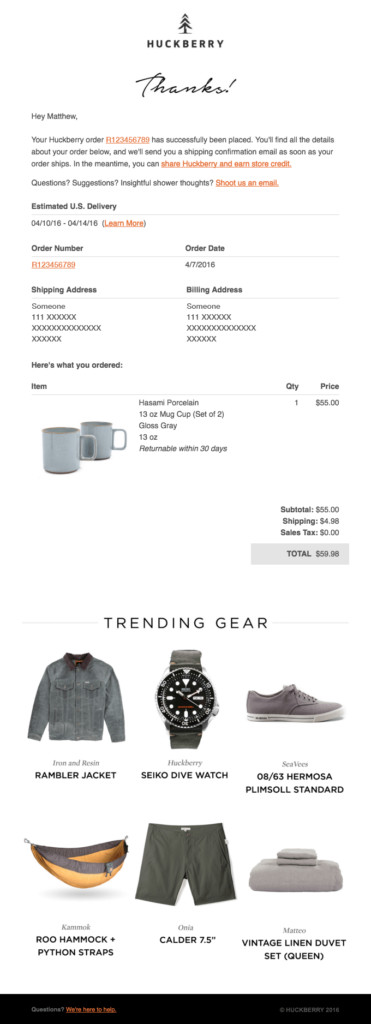
You can do this by showing them positive reviews or testimonials from your satisfied customers. Trust signals such as reviews and testimonials will help to prevent customers feeling remorse, as well as reduce the number of refund requests you receive from customers who change their mind about their purchase.
With 77% of consumers stating that they enjoy being appreciated by brands (TDBank), you should make sure also to include a thank you note in your order confirmation email. This will help you start building a relationship with your customers.
Since order confirmation emails get very high open rates (around 70%), they’re the perfect place to try to upsell or cross-sell to your customers by showing them various products related to their purchase. You can also include your best-selling products at the bottom of your order confirmation email.
3) Post-purchase follow-up email
The post-purchase follow-up email is most frequently used to ask customers to review their purchase. This helps ecommerce businesses gather more social proof for their products.
If you’re using this type of email to generate reviews, it’s crucial that you make the reviewing process as simple as possible. This will ensure that you get as many reviews as you can from your customers.
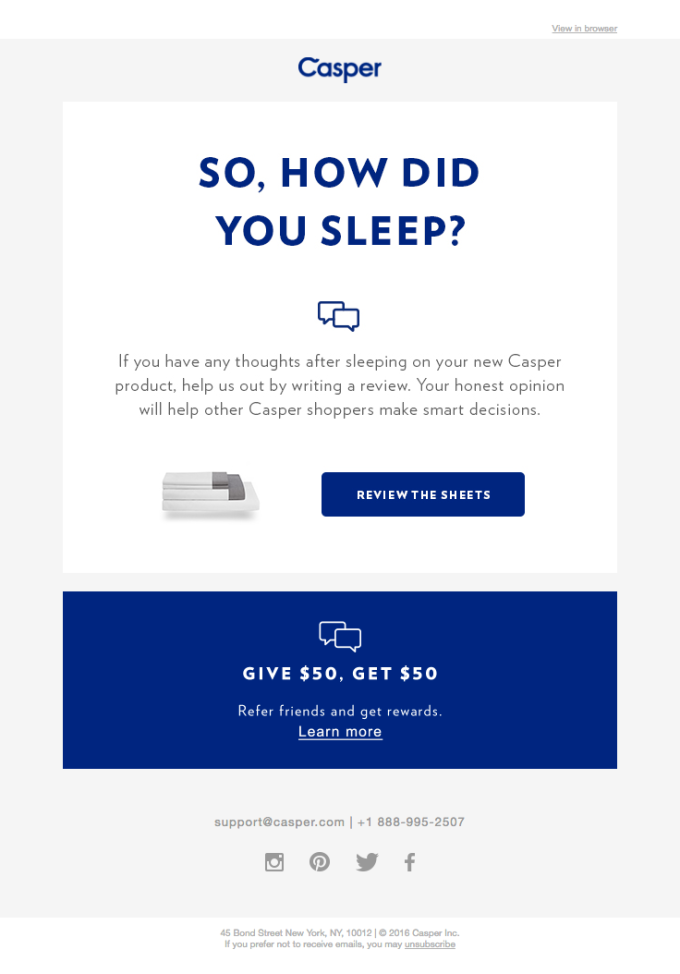
Gathering reviews isn’t the only thing you can do with the post-purchase email. This type of email is also the perfect opportunity to get customers back to your website to make another purchase.
This shouldn’t be that hard, considering that customers who’ve bought from you previously are 27% likely to visit your website again (SumAll).
The best way to incentivize these shoppers to get back onto your website is to offer them a special offer (e.g., free shipping) or a discount.
4) Abandoned cart email
Abandoned cart emails are emails that are sent to shoppers that add products to their cart and then leave without completing their purchase. With 69% of all shopping carts being abandoned (Baymard), sending abandoned cart emails is crucial for ecommerce businesses that want to grow their revenue.
Abandoned cart emails have a 45% open rate. On average, 10.7% of these emails result in a purchase (Moosend), which makes them the highest-converting type of ecommerce email out there.
You can additionally improve this conversion rate by optimizing your abandoned cart emails.
A great abandoned cart email is personalized for each specific customer. This means that it addresses the customer by their name, as well as reminds them of the exact products they left behind.
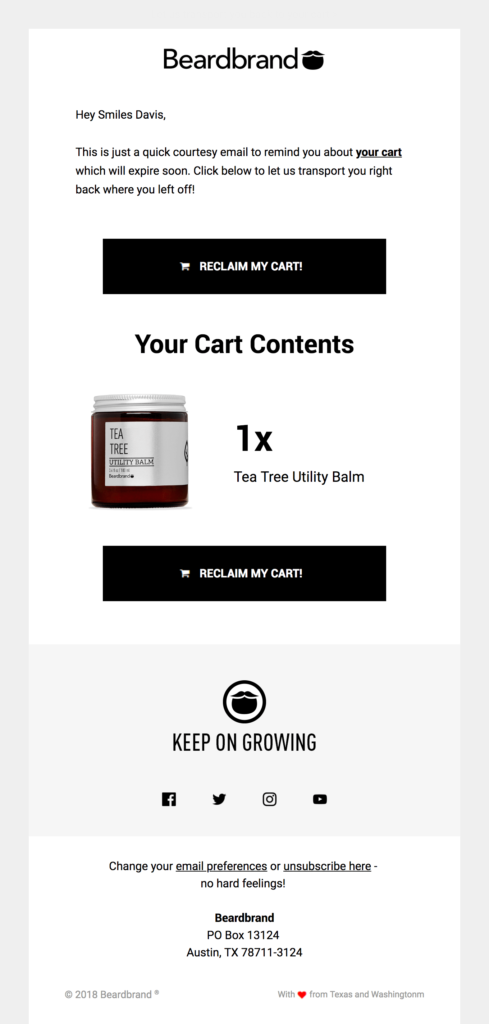
You should also try to create a sense of urgency with your abandoned cart emails to entice shoppers to complete their purchase straight away. A great way to do this is by including a limited time discount which customers can use to save money on their order.
It’s been shown that businesses that send three or more abandoned cart emails recover 69% more orders than those that send just one email (Omnisend).
If you opt for using a series of abandoned cart emails, don’t include a discount code in the first email. This will ensure that you don’t train your shoppers to always wait for a discount before making a purchase.
Additionally, simply reminding shoppers what they left behind will frequently be enough to get them to finish their purchase, so including a discount will just be costing you revenue. If the first email doesn’t manage to convince shoppers to buy, you can include a discount in your second or third email.
5) Upsell & Cross-sell email
Since it’s five times more expensive to acquire a new customer than to keep an existing one (Invesp), ecommerce businesses that want to grow should be focusing on selling more to their existing customers.
One way to do this is by sending out upsell and cross-sell emails. These types of emails can help you improve customer retention and increase customer lifetime value significantly.
They’re very effective because they’re only sent to your existing customers. People who’ve already purchased from you are familiar with your brand and have shown interest in your products.
They’ve also overcome any objections that they might have had about purchasing from you previously. All of this makes them very likely to make another purchase.
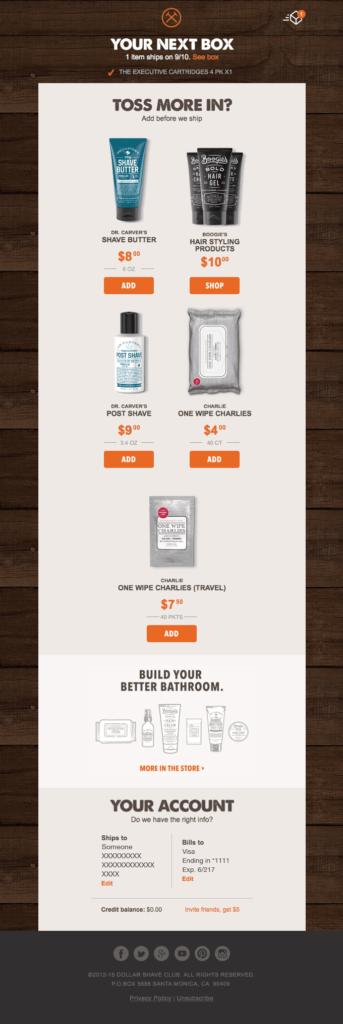
You can email customers about your best-selling products or products related to their previous purchases. You can also remind customers about products they’ve viewed on your website but haven’t purchased yet.
This is especially effective when combined with a discount or a free shipping offer.
When recommending products through this type of email, it’s important that you offer customers reasonable alternatives to the products they’ve purchased or want to purchase. For example, if a customer previously viewed a $200 watch, it wouldn’t make any sense to offer them a $20,000 one instead.
Remember to keep your upsell and cross-sell offers both subtle and reasonable. It’s also important not to give your customers too many options since this might overwhelm them by causing what’s known as the paradox of choice (TechTarget).
6) Re-engagement email
You surely have customers who haven’t bought from you or visited your website in a while. Re-engagement emails can help you find out why this happens, as well as enable you to get some of these customers back to shopping on your website.
Send your inactive customers an email to let them know that you’ve missed them. Ask if there’s something that might be holding them back from buying from you.
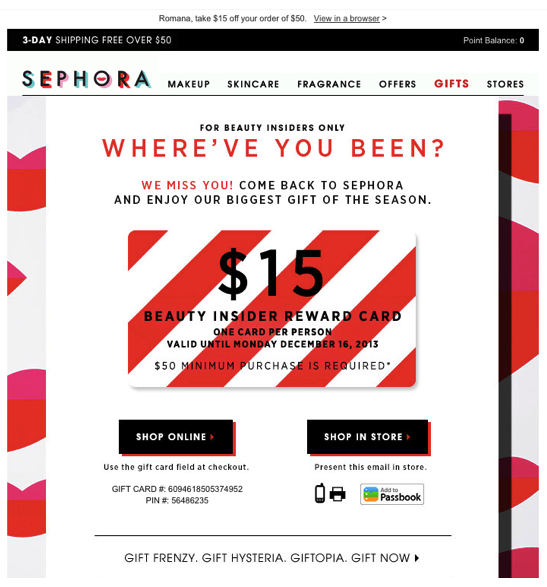
Perhaps you’ll find out that you’ve been doing something wrong, or that your website hasn’t been working properly. Whatever issue customers report, make sure to fix it as soon as possible.
You might also want to include a discount code within the re-engagement email to see if that might entice customers into making a purchase.
Start sending these six ecommerce emails
Since email is the most profitable marketing channel for ecommerce businesses, it’s crucial that you work on improving your ecommerce email campaigns.
The one email you should always send to your new customers is the welcome email. You can use it to introduce shoppers to your brand as well as give them a discount on their first order.
Once customers make a purchase, you should also send them an order confirmation email to let them know that their order has been received, as well as to reassure them that they’ve made the right decision by buying from you.
You can use post-purchase follow-up emails to gather reviews from customers who’ve already received their packages.
Shoppers who leave products in their cart without making a purchase should be sent an abandoned cart email to remind them what they’ve left behind and try to entice them to complete their order.
To improve customer retention and customer lifetime value, ecommerce businesses should also send their existing customers upsell and cross-sell emails and offer them other products that might interest them.
Finally, inactive customers should be sent re-engagement emails to try and get them back to shopping with your business again.